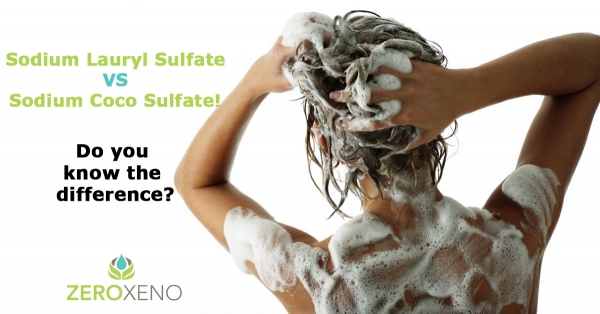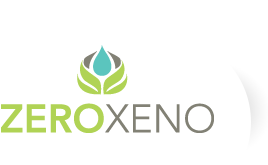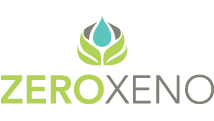Our products are proudly manufactured in Canada and are a product of Canada.
Sodium Lauryl Sulfate vs. Sodium Coco Sulfate
July 27, 2017

Understandably many people today are confused about the potential health and environmental hazards associated with surfactants, in particular sodium lauryl (dodecyl) sulfate, sodium laureth (lauryl ether) sulfate and sodium coco sulfate (SLS/SLES/SCS). Some companies claim that SCS is a safer alternative to SLS/SLES since it's derived from coconuts and not petroleum. Other companies say the SLES is gentler on your skin because it goes through the additional process of ethoxylation. I figured it was time to dig out what science has to say so you can form your own opinion on the matter.
What's the Difference?
SLS/SLES both start out using one fatty acid called lauric acid which is usually sourced from petroleum oil but sometimes from coconut or palm oil. Lauric acid is converted to lauryl alcohol and SLS is created. SLS is a known skin irritant so it's put through the additional process of ethoxylation to make it more gentle. In fact SLS is used by scientists to irritate the skin of animals and human volunteers in order to test the effectiveness of various different healing agents on SLS inflamed skin!
SCS is similar to SLS, its main difference is that it is derived only from coconut oil and uses a blend of fatty acids that exclude the lauric fatty acid. Both surfactants are produced using the same process of treating fatty acids with a type of sulfuric acid and then neutralized with an alkali, but because of the lack of lauric fatty acid in SCS, companies can claim on their label that their products are SLS-Free.
Sodium coco sulfate (SCS) is a blend of:
-
sodium caprylic sulfate
-
sodium capric sulfate
-
sodium oleic sulfate
-
sodium stearyl sulfate
-
sodium myreth sulfate
-
sodium dodecanesulfate
-
sodium monododecyl sulfate
-
and others
Sadly, SLES and other surfactants are often contaminated with 1,4-dioxane, due to the ethyoxylation process it goes through to make it less irritating to the skin. 1,4 dioxane permeates the end products SLES is used in children's shampoos and other consumer personal care products. Many scientists regard various other surfactants as a health hazard due to their potential 1,4-dioxane content. The Environmental Protection Agency (EPA) and the Center for Disease Control (CDC) in the USA has declared 1,4-dioxane as an emerging contaminate as it's perceived as a potential health hazard to humans and the environment. The dangers associated with 1,4-dioxane are various but can include cancer, miscarriage and stillbirths.
Other surfactants that utilize the ethoxylation process also incorporate the use of phenols which are reported in laboratory studies to have estrogenic properties that mimic the effects of estradiol. It is important to note that the US Environmental Protection Agency (EPA) has developed a plan to help industries choose safer surfactants because of their concerns over potential ecological and other dangerous impacts of such surfactants.
The estrogen activity (EA) of ethoxylated surfactants have been linked to breast cancer due to the phenol that is added during the manufacturing of alkylphenol and nonylphenol surfactants. Synonyms for phenol include carbolic acid, benzophenol, and hydroxybenzene. It is interesting that this same phenol is utilized in the manufacturing process of the estrogenic chemical bisphenol A (BPA) which is used to harden polycarbonate plastic water bottles. In case you were wondering, the single largest market for phenol is in the production of BPA, which is manufactured from phenol and acetone (acetone is the main ingredient in nail polish remover).
BPA is a known xenoestrogen (foreign chemical that acts like estrogen) which affects male and female fertility, is linked to breast cancer, polycystic ovary syndrome and a number of other hormone related illnesses. And yes, you should learn how to avoid BPA, but this is a subject matter for another day!
To be clear, SCS is not put through the ethoxylation process and therefore is not likely contaminated with 1,4 dioxane, however it is put through the sulfation process and the fatty acids are treated with a type of sulfuric acid. Currently, there are no studies that state SCS has any estrogen activity (EA).
Green Washing
Be wary, many natural companies are playing the 'Green Washing Game' with you. They say their formulations are SLS/SLES-Free, but if you look on their list of ingredients they are in fact using SCS or some other form of SLS/SLES like ammonium lauryl sulfate (ALS) or alkylphenol/nonylphenol surfactant. You decide if they're telling the truth or not about being sulfate-free. This same principle applies to sodium dodecyl sulfate (SDS) and/or multiple other names used to hide the chemical processes used to manufacture SLS/SLES.
There are two clues you can look for to discover if your favorite brand is secretly using SLS/SLES/SCS. The first is in the ingredient name and the second is in its bubble capacity. Ingredients that contain 'laureth' 'eth' 'lauryl' or 'sulfate' somewhere on the list of ingredients should be your first warning sign. If your product bubbles and foams excessively when only a small amount is used, that should be your second danger signal. A great way to test your product is to run a little experiment. If you can create a voluminous bubble bath with a small dollop of product (about the size of a dime) you may want to purchase a different brand.
Safe Saponification
To be sure that you're using safe surfactants, look for those that have gone through the old-fashioned process of saponification, like Castile soap. Saponification may sound like a big scary word, but really it’s just a fancy term for the age-old soap making process that grandma used for centuries. The name saponification literally means 'soap making' as the root word, 'sapo' is Latin for soap.
To discover other simple ways to avoid the 'Green Washing Game' and make healthy choices for you and your family, check out my blog on 'The 7 Deadly Estro-Sins'.
Join The Zero Xeno Movement today!
by Bonnie Penner
All Zero Xeno (ZX Enterprises Inc.) products are for external use only. All advice and information posted on this website is from personal research and/or experience and is intended for general educational purposes. Our intent is not to diagnose, treat, cure or prevent any disease. The information on our site is not intended to be a substitute for professional medical advice related to specific medical conditions. We cannot diagnose illnesses nor confirm any claim as to therapeutic safety, effectiveness or course of treatment. Always seek the advice of your physician or other qualified health professionals for any concerns regarding your health. Only your physician can provide specific diagnosis and treatments. Please refer to our full Disclaimer for more details.
- Log in to post comments



